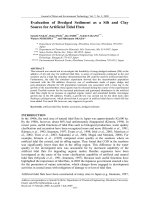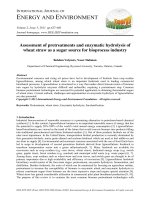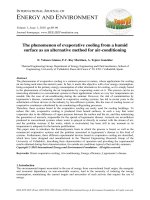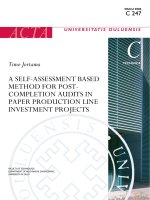Cryogenic biogas enrichment method for use as a vehicle fuel
Bạn đang xem bản rút gọn của tài liệu. Xem và tải ngay bản đầy đủ của tài liệu tại đây (312.25 KB, 5 trang )
Int.J.Curr.Microbiol.App.Sci (2019) 8(5): 683-687
International Journal of Current Microbiology and Applied Sciences
ISSN: 2319-7706 Volume 8 Number 05 (2019)
Journal homepage:
Original Research Article
/>
Cryogenic Biogas Enrichment Method for Use as a Vehicle Fuel
A.M. Tesfit, T.M. Mahtem and L.B. Joejoe*
Department of Agricultural Engineering, Hamelmalo Agricultural College
*Corresponding author
ABSTRACT
Keywords
Biogas, Biogas
upgrading,
Cryogenic method,
Compression,
Expansion,
Bioreactor
Article Info
Accepted:
10 April 2019
Available Online:
10 May 2019
Energy content of biogas is directly proportional to the methane concentration thus,
removing impurities increases the energy content of the gas so that it can be used as
vehicle fuel or pooled into gas grid. Removing impurities is regarded as biogas upgrading,
in doing so, cryogenic method is among different enrichment methods. Cryogenic method
involves the subsequent compression and expansion of biogas until the suitable pressure
and temperature is attained (in other words until the required purity is attained). With this
method the suitable temperature and pressure to remove CO 2 and H2S are calculated to be
215K and 1MPa respectively. At this point while CO2 and H2S are in their liquid state,
CH4 exists in its gaseous state. Under these conditions, CO2 and H2S are removed from the
system under the action of gravity. The minimum work done to compress the gas is
0.5MJ/kg.
option due to rapid growth in the price of
fossil fuels (Kadam, and Panwar, 2017) and
(Ogur, and Irungu, 2013). On this basis,
impurities must be removed or reduced to a
minimum level based on the purpose of use of
biogas.
Introduction
The process of gas production from anaerobic
degradation of organic substrates, namely
manure, sewage sludge, organic household
leftovers and industrial wastes is regarded as
biogas production (Deublein and Steinhauser,
2008). The production of biogas and its
efficient utilization would meet the fuel and
energy demand (Kruczynski, et al., 2012).
Biogas released from reactors consists of
varieties of impurities that reduce the
efficiency of the gas and also causes adverse
effects on the network during its use, ranging
from the reactor to the point of its use. Biogas
has wider industrial applications, for this
reason upgrading is necessary. Biogas
enrichment has been timely and suitable
Apart from avoiding the adverse effects of
impurities from the biogas, upgrading of
biogas increases the concentration of
methane, in other words enhances the
calorific value or energy level of the biogas
(Papacz, 2011). This is because; energy
content of biogas is directly proportional to
the methane concentration. Hence, removing
carbon dioxide increases the energy content
of the gas (Petersson and Wellinger, 2009).
683
Int.J.Curr.Microbiol.App.Sci (2019) 8(5): 683-687
Water and siloxanes are removed when the
gas is cooled. Further availability of water is
checked in the gas driers figure 1. The
sublimation point of pure carbon dioxide is
194.65 K (Petersson and Wellinger, 2009).
However, the methane content in biogas
influences the characteristics of the gas, i.e.
higher pressures and/or lower temperatures
are necessary to condense or sublimate carbon
dioxide when it is mixed with methane.
Cooling usually takes place in several steps in
order to extract the various gases in the biogas
individually and optimize energy recovery. At
the beginning of the process biogas is
compressed, to a targeted pressure P2 as a
function of which the temperature T2 is
calculated by the expression below (kirillin et
al., 1983).
Materials and Methods
Biogas comprises of a number of gaseous
impurities. Of all the impurities, method of
removing of carbon dioxide (being the largest
in proportion by volume) and hydrogen
sulfide (being corrosive to metallic
components), is aimed in this article.
Pooling biogas to a gas grid or using it as
vehicle fuel demands the enrichment of
methane to 95%, requiring the removal of
CO2 (Papacz, 2011). In other words, the
volume of biogas is reduced by 40%. Various
methods for removing CO2 and H2S from the
mixture can be made based on different
requirements. However a focus is only put on
cryogenic biogas cleaning.
Cryogenic biogas cleaning
T 2 T1 *
The science of low temperatures is one of the
processes used to separate the gaseous
components of biogas from each other. It uses
the temperature difference properties of the
type of gases. This process of biogas
enrichment is used to create a gas or liquid
containing mainly methane and light
hydrocarbons. A simple (single stage)
schematic diagram of upgrading process is
shown below in figure 1.
P1
P2
n 1
n
(1)
The minimum work done to compress the gas
to the required pressure is determined by
equation (2) (Kirillin et al., 1983).
P
L
* R * T1 * 2
P
n 1
1
n
n
n 1
1
μ R 8 .3 1 4 M J / ( m o l . K )
The process begins with the compression of
biogas up to 10Mpa. Several heat exchange
steps are used progressively figure 2 to cool
the biogas to a lower temperature, allowing
CO2 and H2S to be liquefied and separated.
(2)
(3)
where R is the universal gas constant, and μ is
the molecular weight of a mixture of CH4 and
CO2
Results and Discussion
Cryogenic upgrading allows the use of
various boiling points or sublimations of
various gases, especially for the separation of
carbon dioxide and methane. Raw biogas is
cooled down to temperatures where carbon
dioxide in the gas condenses or sublimates
and gets separated as a liquid or solid while
the methane is accumulated in the gas section.
From the reactor, biogas is compressed and
gets expanded through a nozzle into a
separator figure 3. As a result, its temperature
decreases from a temperature range of (300 450K) to (215 -270K), and pressure decreases
from 10 to 1 MPa (Fig. 5). Under these
conditions, CO2 and H2S are condensed and
684
Int.J.Curr.Microbiol.App.Sci (2019) 8(5): 683-687
liquefied and removed from the system under
the action of gravity (Xu et al., 2014). The
minimum work done to compress the gas is:
0.5-0.6MJ/kg.
al., 2011) (Fig. 5), to find the best point that
fits well in the shaded area.
CO2 and H2S are gases under normal
conditions. The triple points where CO2 and
H2S exist in all three states (solid, liquid and
gas) at equilibrium are 216.4K and pressure
of 0.52MPa and 187K and 0.02 MPa
respectively. Figure 4 shows the overlap of
the thermodynamic
properties (phase
diagram) of both CO2 and H2S and
compression-expansion process of biogas. As
it can be noted, the liquid state region of CO2
lies well within that of H2S, indicating
common liquid state range of pressure and
temperature.
Enriched biogas under pressure of 1MPa and
a temperature of 215 -270 K is compressed
again to a pressure of 20 - 25 MPa and filled
into balloons or fed into gas grid.
The figure 4 shows biogas compression and
expansion processes at different polytropic
indices. The solid lines describe compression,
while the broken lines show the results of
subsequent gas expansion. This graph is then
superimposed on the CO2 and H2S phase
diagrams (Lange et al., 2016) and (Goos et
Fig.1 Schematic diagram of cryogenic enrichment
Fig.2 Sectional view of heat exchanger
685
Int.J.Curr.Microbiol.App.Sci (2019) 8(5): 683-687
Fig.3 Sectional view of a separator
Fig.4 Compression and expansion of biogas
Fig.5 Phase diagrams of CO2 and H2S, and compression-expansion of biogas overlaps
The aim of this article is to address the
separation of CO2 and H2S from the biogas by
cryogenic method. Since this method requires
compression of gas mixture, it demands energy
source to compress the gas and bring the
targeted impurities to their liquid phase so that
they can easily flow and get separated from the
system. Taking these two key ideas into
686
Int.J.Curr.Microbiol.App.Sci (2019) 8(5): 683-687
account the optimal point where CO2 and H2S
are liquefied with a minimum energy of
0.5MJ/kg is at a pressure and temperature of
1MPa and 215 K respectively (Fig. 5).
Goos, E., Riedel, U., Zhao, L. and Blum L.,
2011. Phase Diagrams of CO2 and
CO2-N2 gas mixtures and their
application in compression processes.
Energy procedia. 4. 3778-3785.
Kadam, R., and Panwar, N., 2017. Recent
advancement in biogas enrichment and
its applications. Renewable and
Sustainable Energy Reviews. 73. 892–
903.
Kirillin V.A., Sechev V.V. and Sheyndlin A. E.,
1983. Technical Thermodynamics,
Moscow, Energoatomizadat. p. 409.
Kruczynski, S.W., Pawlak, G. and Woloszyn,
R., 2012. The concept of the Tractor
Powered by Biodiesel and Biogas.
Journal of KONES Powertrain and
Transport, Vol. 19, No. 4.
Lange, S., Campestrini, M. and Stringari, P.,
2016. Phase behavior of system
methane and hydrogen sulfide. AIChE
Journal, wiley 62(11).
Ogur, E. O., and Irungu, P., 2013. Design of a
Biogas
Generator.
Concurrent
Engineering Research and Applications.
3. 2248-2296.
Papacz, W., 2011. Biogas as Vehicle fuel.
Journal of KONES Powertrain and
Transport, Vol. 18, No. 1.
Petterson, A., and Wellinger, A., 2009. Biogas
upgrading technologies developments
and innovations. International Energy
Agency, IEA.
Xu, G., Liang, F., Yang, Y., Hu, Y., Zhang, K.
and Liu W., 2014. An Improved CO2
Separation and Purification system
Based on Cryogenic Separation and
Distillation Theory. Energies. 7, 348435.
After removing CO2 and H2S, methane is recompressed to fill it into cylinders. While
compressing a biogas, naturally, a considerable
amount of heat, which can be used to
supplement heat to the bioreactor (when
required) or other purposes, is generated.
In conclusion, depending on the temperature of
the process, various degrees of purity can be
achieved. A lower temperature results in higher
carbon removal efficiency.
The advantage of the cryogenic method is that
its operation does not require water or an
absorbent, although it requires external cooling
equipment, such as a refrigeration cycle or the
addition of liquid nitrogen as a coolant.
In this study, however, circulating water is used
as a cooling means. Whenever bioreactors are in
cold climatic regions, hot water circulation
around the substrates of the bioreactor is used to
maintain the temperature of the reactor.
Therefore, heat removed from the compressed
biogas can be carried from the heat exchanger
through the circulating water to the bioreactor
as a supplementary heating system.
References
Deublein, D., and Steinhauser, A., 2008. Biogas
from Waste and Renewable Resources.
Weinheim, Germany WILEY-VCH
Verlag GmbH & Co.KGaA, p. 450.
How to cite this article:
Tesfit, A.M., T.M. Mahtem and Joejoe, L.B. 2019. Cryogenic Biogas Enrichment Method for Use
as a Vehicle Fuel. Int.J.Curr.Microbiol.App.Sci. 8(05): 683-687.
doi: />
687









